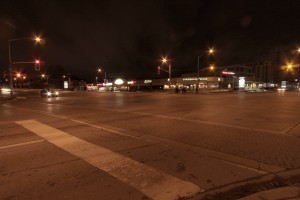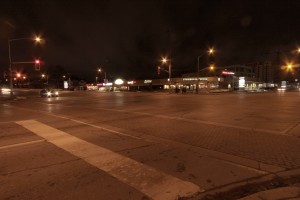‘Pedestrian scramble’ debated by Region


A report issued last year by the Region of Waterloo evaluated the congested intersection at King St. and University Ave. and proposed solutions to make it safer for drivers and pedestrians.
One of the suggestions was a “pedestrian scramble,” which has been a debated by city counsellors for a number of years.
A pedestrian scramble involves creating phases in the traffic lights where pedestrians can walk simultaneously in all directions while all lanes of traffic are stopped. This model would mirror Toronto’s Yonge St. and Dundas St. intersection.
“I think there’s room for improvement at that intersection, given the number of pedestrians in that area [and] it is the core of the university and pedestrians,” said Jeff Casello, a University of Waterloo professor of transportation. “But with the current geometric state of the intersection, I do not think that it is the best option.”
The heavy volumes of motor vehicle traffic and pedestrians have given the King and University intersection a reputation of being chaotic and at many times dangerous.
Data recorded by the Region of Waterloo estimated daily traffic at this intersection is at approximately 40,000 vehicles and 6,000 pedestrians per day.
Between September 2007 and September 2012 there was also a recorded 12 collisions at the King and University intersection that involved pedestrians.
So far, the Region has installed a count-down light at the crossing, but are also looking at other options.
The aim of a pedestrian scramble would be to lessen the amount of pedestrian-related accidents that frequent this crossing. It was suggested out of a March report in order to improve safety and reduce congestion.
Brianne Brothers, a Wilfrid Laurier University student, liked the idea of a pedestrian scramble, describing the current intersection as a “mad dash of students trying to get where they need to go.”
However, some concerns at a regional level have been brought up, questioning whether a scramble is truly the best solution for a traffic issue.
“It has a lot more pitfalls to this solution than opportunities,” said Region of Waterloo councillor Geoff Lorentz.
“We shouldn’t make drastic changes until the situation is drastic.”
“I don’t think we’re there yet.”
The pedestrian scramble would allow approximately 40 seconds for the pedestrians to walk.“It is difficult to make it from one side to the other in that time at the rate of an average walker, let alone someone of disability,” Casello added.
Casello also argued that based on the geometry of this intersection it is “difficult to make it function” and that cars and pedestrians would be “dissatisfied.”
“This advanced sequence of traffic regulation would also take the intersection out of coordination with other intersections,” he said, worried that a scramble would result in cars having to wait longer at street lights.
Recommendations continue to be made on the issue and the Waterloo council are looking into other alternatives, as the pedestrian scramble was just one suggested option. Lorentz explained that the Region is always looking at different ways to “improve the safety of pedestrians.”
He also addressed the responsibility of both the driver and the pedestrian when it comes to crossing an intersection.
“Measures put in place are only as good as the people who obey them and use them,” he said.

